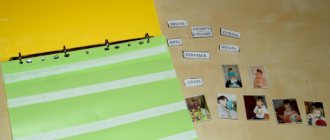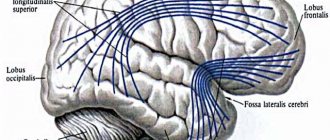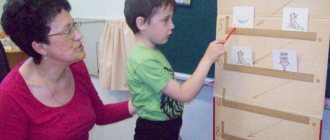OSD is a general underdevelopment of speech. This disorder affects all aspects of the child’s speech, that is, its sound, lexical, grammatical, and semantic components. Manifestations of OHP depend on the insufficient development of various components of the speech apparatus. They can vary from complete absence of speech to speech, with elements of phonetic, lexical and grammatical underdevelopment. This disease is detected by a special diagnosis by a speech therapist. The correction program and its features are established individually by the attending physician.
Among all children with speech disorders, children with ODD make up about 40%. Its strong and profound manifestations may in the future manifest themselves as dysgraphia and dyslexia. Speech therapists use the term phonetic-phonemic development or FFN and OHP to designate the immaturity of the speech system. OHP in children can be observed in the presence of dysarthria, alalia and other disorders.
Classification
According to the clinical picture of manifestations of ONR, it is divided into three groups:
- Uncomplicated form. Such children have minimal brain dysfunction, insufficient regulation of muscle tone, and immature volitional and emotional spheres.
- Complicated form. Occurs in patients with a number of neurological or psychopathic diseases, convulsive, cerebrasthenic and others.
- Gross underdevelopment. Children have lesions in the speech areas of the brain, that is, in the presence of alalia and dysarthria.
OHP also has its own degrees of severity. There are four in total:
- first degree - speechless, with the absence of commonly used speech;
- second degree – there are basic elements of common speech, poor vocabulary, agrammatism;
- third – the presence of phrasal speech, with underdevelopment of sound and semantic components;
- fourth degree – some problems in the phonetic-phonemic and lexical-grammatical aspects of speech.
Depending on the degree of complexity, the duration of correctional work of OHP by a speech therapist is determined.
Characteristics of speech of children with NDD
Recently, level IV ONR or NONR (mildly expressed general underdevelopment of speech) has been isolated. Preschoolers with NLD do not have serious problems with sound pronunciation, but with rapid speech, sounds are mixed or replaced. The narratives are incomprehensible, inexpressive, sluggish.
The vocabulary of such children does not differ from that of their peers without speech problems. For coherent speech, it becomes typical to “obsess over” minor details and omit the main ones, repeating certain points. The stories are not very informative. NONR is diagnosed from the age of 6 years.
Characteristics of degrees
Each degree of OSD has a certain relationship between primary and secondary speech defects, which inhibit the formation of its components. The transition from one level to another is determined by the presence of new speech capabilities and changes in its activity. The most persistent manifestations of OHP are observed with motor alalia, and less often with stuttering or rhinolalia. There are only four degrees of OHP.
ONR first degree
This disorder is characterized by a complete absence of speech, and this degree is detected immediately. It manifests itself in the following:
- Vocabulary is extremely limited. For communication, the simplest babbling words, fragments of words, syllables or onomatopoeia are used. At the same time, the baby loves to communicate, but speaks with the people around him in “his own” language. That is, the child has in his speech such words as “woof-woof”, “meow-meow”, “too-too” and the like.
- A preschooler with the first degree of OHP actively uses appropriate facial expressions and gestures and carry a semantic load. The child uses these techniques to express himself, and the adult makes every effort to understand them.
- Speech does not contain sentences or phrases consisting of several words. Only individual amorphous words with a general meaning are observed, for example, the phrase “woof-woof tu-tu” means that the dog rode the train.
- Passive vocabulary significantly exceeds active one. The baby understands speech addressed to him, but is unable to say anything.
- Words with complex composition and structure are kept to a minimum, long complex words are simply abbreviated, but their meaning can be understood. For example, the word bus may sound like abus, or tube.
ONR second degree
OHP type 2 differs from the first degree in the presence in the child’s speech of a small number of commonly used words; they may not be pronounced quite correctly. The beginning of the formation of connections between words may also be noticeable, but this is still on an unstable basis. The following symptoms are typical for grade 2 OHP:
- The child uses one word that denotes an object or some action, but in a modified form. For example, the word "bus" will sound like "abous" in any context.
- The active vocabulary is very limited; with OHP 2, they do not know all the words denoting some characteristics of an object, for example, a description of its shape, color and other characteristics.
- The child does not have the skill to combine objects into certain semantic groups, for example, tableware - spoon, fork, plate.
- The pronunciation of many sounds, words, and phrases is impaired.
Also, characteristic features of type 2 OHP are the presence of rudiments of grammatical changes depending on the complexity of the word itself. The more letters there are in a word, the more mistakes and violations the child makes in it. He actively uses words in his speech, but does not coordinate them with each other. This is how the phrases “mama kupa” appear - “mom is bathing. Thus, prepositions are simply missed or used incorrectly. The patient can make up a short story based on the picture shown and the active assistance of the parent. However, this story turns out to be extremely modest. Usually two or three syllable sentences are used. In OHP 2, the words themselves are greatly distorted, and the pronunciation of words with a polysyllabic structure is impaired.
OHP third degree
This degree is characterized by a delay in the grammatical and phonetic speech components. The child has active expressive speech and is able to construct individual phrases and has a fairly large vocabulary. The problem points of speech are:
- communicates only with parents, with other people only with a “translator”;
- sound pronunciation is not fully formed;
- in independent speech, sounds may sound incorrect;
- more complex sounds are replaced by simple ones;
- has difficulty with hissing, whistling and sonorant sounds;
- one and the same sound can replace several;
- The vocabulary is expanding, but only a small part of it is used.
Grammar is also impaired in grade 3 OHP, but the child tries to construct complex sentences, but difficulties arise with their pronunciation. The child may not formulate sentences correctly, but can create a short story. Another distinctive feature is inconsistent grammatical errors, that is, in one sentence the same error is made, but not in another phrase. The baby may lag behind in his phonetic abilities, manifested in the so-called difficult words. All these factors delay the process of preparing a child for school.
OHP fourth degree
This degree is characterized by the presence of only some difficulties and errors in speech. This creates an overall picture that prevents you from fully mastering speech, sound understanding and pronunciation. The main thing for parents in this case is to contact speech therapy specialists in order to correct all existing deficiencies as quickly as possible. Characteristic signs of OHP type 4 are:
- there are no obvious violations of sound pronunciation, the sounds themselves are delivered correctly;
- speech is slurred with unclear, blurred sound pronunciation;
- there are violations of the structure of syllables, expressed in the replacement of sounds with similar ones;
- incorrect use of certain words denoting characteristics of a particular object;
- the child may not understand or confuse the phrases “long table” and “high table”;
- difficulties in choosing the correct suffixes;
- Agrammatisms may occur, but their number is minimal.
Violations characteristic of level 4 OHP are not so common. Speech is characterized by criticality, and the grammatical structure itself is close to its norm.
Characteristics of speech in OHP level I
With level I OHP, most sounds are absent. Most often, the sounds of early ontogenesis remain undisturbed. Preserved sounds are unstable in use. In speech, the leading place is occupied by short words of one or two syllables. When trying to pronounce a longer word, the child skips syllables.
Children have difficulty distinguishing even non-speech sounds that are distant in sound. Both passive and active vocabulary are sharply limited. Kids mostly communicate non-verbally; they have well-developed facial expressions, gestures, and intonation.
When communicating verbally, onomatopoeic phrases are used, their fragments, words that are not similar to any others, “lightweight, childish”, used by one of the elders in conversations. The same word can be used to denote several concepts. The preschooler does not have phrasal speech or monologue. Level I OHP is diagnosed at the age of three.
Reasons for OHP
The causes of OHP are mainly problems during pregnancy or childbirth, as well as in the first years of the baby’s life. The most basic reasons for OHP:
- infectious diseases of the mother during pregnancy;
- toxicosis;
- birth injury;
- asphyxia, hypoxia;
- incompatibility of mother and child by Rh factor;
- disorders in the central nervous system;
- head injuries of a baby in his first years of life;
- the influence of nicotine, alcohol, drugs;
- deprivation.
Social reasons are also important. This may be due to insufficient communication with the child. Often this form of OHP occurs in children living with their parents who have hearing problems. The attention of adults to it has a noticeable effect on speech skills and should be given a lot of time.
Pathogenesis
OHP should be considered as a systemic disorder that affects language subsystems, that is:
- phonetic-phonemic;
- grammar;
- lexical;
- semantics.
Level 1 OHP in a child causes him to lag behind accepted age norms. This happens across the entire spectrum of indicators, both quantitative and qualitative. Such children have disturbances in the general course of speech development, the timing, and the order in which they master articulatory skills. Experts compare general speech development with linguistic infantility.
The very mechanism of the appearance and development of general speech impairment has a close connection with primary speech defects and their direct causes. In the presence of disorders of cerebral-organic origin, such as alalia or aphasia, severe speech disorder may occur, as well as misunderstanding of the speech of others.
Thus, speech pronunciation and its perception suffer. If there are anatomical defects, insufficient development of the speech apparatus, the syllabic structure of words disintegrates, and the lexical and grammatical basis of statements is disrupted.
Characteristics of speech with OHP level III
With level III OHP, the range of problematic sounds is from 2 to 20. It is characterized by all types of sound pronunciation disorders. The syllable structure is distorted according to the same principle as at level II, but the use of words with a large number of syllables is problematic. Five-syllable words are difficult.
Children distinguish sounds that are distant in sound and pronunciation, but find it difficult to differentiate sounds that are close in parameters. Begin to become familiar with the processes of reading and writing. Children are left with a poor passive vocabulary. The active vocabulary is sufficient for everyday situations. There are multiple substitutions of words that are similar in meaning. Typically incorrect understanding and use of generalizing concepts.
Word formation becomes available. But when forming words, a preschooler makes many mistakes: he uses suffixes incorrectly, and chooses the wrong stem. A monologue is characterized by a small volume, omission of large parts, inversions, and violation of logical and temporal connections.
Errors in inflectional processes appear much less frequently. Level III OHP is diagnosed after 5 years.
Diagnostics
The diagnosis of onr can only be made by conducting a comprehensive study. Diagnosis is carried out at an initial consultation with a speech therapist. The specialist establishes contact with the child, the parents must have medical reports from a neurologist, pediatrician, and the results of the studies. Having received all available information, the specialist studies and determines the speech status of his patient.
Speech therapy research is carried out in two stages - orientation and language examination. The orientation is carried out through a conversation with parents. This way, all the features of the course of the disease are clarified, what reasons accompanied it, and how the speech apparatus developed. The patient himself is also assessed - his ability to make contact, articulatory motor skills.
When examining the language and its components, the formation of speech, its coherence, grammar, and vocabulary are determined. In the case of the presence of OHP of the first degree, there is a gross underdevelopment of all components of the language system, which is explained by the child’s lack of commonly used speech. After this, the specialist can draw up his conclusion and establish the clinical form of the pathology of the speech apparatus.
It is important to distinguish insufficient speech development from other forms, such as speechlessness, autism, mental disabilities, hearing impairments, etc.
Recommended speech therapy examination
It is worth studying in detail the vocabulary of a person suffering from OPD. This will allow you to assess the ability to correlate a word with a specific subject. This is done in several steps:
- Selection of material, divided into individual lexical topics. This determines the child’s ability to communicate with the people around him.
- Pictures with objects are offered.
- Pictures with names of body parts are used.
- Selection of synonyms for the selected word.
During the diagnosis, the speech therapist must give his conclusion, which indicates the level of speech development, the clinical picture, the degree of OHP, and also draw up a plan for correcting the identified disorders.
Correction of the disorder
Corrective work on OHP should only be carried out by a qualified specialist. Preschool children with the first degree of speech impairment attend special speech therapy groups in kindergarten. They must enter here at the age of 3-4 years, and the classes themselves are conducted in groups, subgroups and individually. The purpose of correction is to transfer the child to another stage of speech development, to compensate for all existing deviations.
This work is carried out simultaneously in various directions:
- Speech understanding. This problem can be better solved by conducting classes in a playful way. The child must find toys that the specialist names for him, show the correct pictures, expand his vocabulary, and master the pronunciation of phrases, phrases, and multi-word phrases.
- Speech activation. Development of onomatopoeia in a child, for example, the voices of various animals, musical instruments. This stimulates his speech activity. Pronouns, verbs, and addressing an adult are gradually introduced into speech.
- Non-speech development. Correct speech is impossible without the development of auxiliary mechanisms - concentration, development of thinking, memory. Much attention should be paid to the intellectual and mental development of the child. Auxiliary techniques include logorhythmics, speech therapy massage, development of fine motor skills and articulation.
At the last stage, sound pronunciation must be performed with correct grammar and speech format. Treatment of second-degree ODD includes the development of the child’s speech skills, his understanding of adult speech, and training of the lexical and grammatical component. At the third degree, coherent semantic speech is formed, vocabulary and grammar are improved, and correct articulation is consolidated. A lot of time should be devoted to mastering the necessary literacy.
For children with SEN IV, it is important to achieve their age-specific speech standards, which is necessary for successful studies at school. Schoolchildren with severe forms of ODD are trained in schools created to work with children with speech disorders. Here the emphasis is on compensation for all aspects of the manifestation of speech underdevelopment1.
Prognosis and prevention
Correction of OHP is a long process, the duration of which depends on the severity of the disease, complications and other physiological characteristics of the child. It is necessary to start this work as early as possible, in this case the chances of completely getting rid of it or minimal manifestations increase. As a preventive requirement, it is necessary to follow all instructions during pregnancy.
Formation of grammatical categories in children with special needs development
Grammatical forms in children with ODD appear in the same order as in a healthy child, but with the presence of some features. They may be slower to learn, and there may be disharmony between speech morphology and syntax. Violations in grammatical structure are explained by the underdevelopment of these particular speech components. Such violations lead to a large number of grammatical errors, manifested in incorrect correlation of morphemes, suffixes, endings, and cases.






